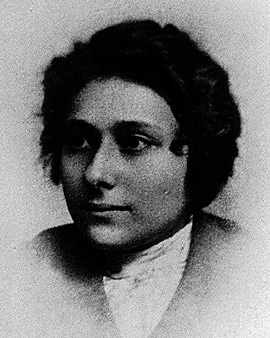


The painter Maria Blanchard, who died in 1881 in Santander and in 1932 in Paris, fascinates with her own cubist pictorial language, which also appears very modern today. Her life resembles a rollercoaster: On the one hand, Maria Blanchard was born handicapped. She was very small, had a hump and could not walk properly. At the same time, Blanchard had a great artistic talent and from 1903, she trained at the Academy of Art in Madrid. This was followed by a scholarship in Paris, among others with the fauvist Kees van Dongen. In Paris, Maria Blanchard became enthusiastic about Cubism, which was emerging at the time. Blanchard dealt with the synthetic Cubism of Juan Gris, which used materials, paper and paint in collages.
The oil painting "Composition with People" from 1916 demonstrates the dissolution of a conventional pictorial structure: as a juxtaposition of angular and round forms, colours and ornaments, Blanchard assembles her painting, in which the Cubist figure also does not assume a prominent or individual position. "Cubist Composition Composition Cubist" pushes this method even more consistently: very strikingly, different, strongly delimited areas of color and ornaments stand here next to each other with equal value.
In order to secure her livelihood, Maria Blanchard taught drawing to pupils between 1914 and 1916. After participating in the exhibition of the "Salon des Indépendants" in 1921, Blanchard was able to achieve temporary financial success. Nevertheless her financial situation was tense; Maria Blanchard remained dependent on patrons. This was due to the uncertain economic situation and her poor health. Regardless of this, the artist's bold work is fascinating, whether it is "Mother and Child" from 1922 or "Woman with Guitar".

The painter Maria Blanchard, who died in 1881 in Santander and in 1932 in Paris, fascinates with her own cubist pictorial language, which also appears very modern today. Her life resembles a rollercoaster: On the one hand, Maria Blanchard was born handicapped. She was very small, had a hump and could not walk properly. At the same time, Blanchard had a great artistic talent and from 1903, she trained at the Academy of Art in Madrid. This was followed by a scholarship in Paris, among others with the fauvist Kees van Dongen. In Paris, Maria Blanchard became enthusiastic about Cubism, which was emerging at the time. Blanchard dealt with the synthetic Cubism of Juan Gris, which used materials, paper and paint in collages.
The oil painting "Composition with People" from 1916 demonstrates the dissolution of a conventional pictorial structure: as a juxtaposition of angular and round forms, colours and ornaments, Blanchard assembles her painting, in which the Cubist figure also does not assume a prominent or individual position. "Cubist Composition Composition Cubist" pushes this method even more consistently: very strikingly, different, strongly delimited areas of color and ornaments stand here next to each other with equal value.
In order to secure her livelihood, Maria Blanchard taught drawing to pupils between 1914 and 1916. After participating in the exhibition of the "Salon des Indépendants" in 1921, Blanchard was able to achieve temporary financial success. Nevertheless her financial situation was tense; Maria Blanchard remained dependent on patrons. This was due to the uncertain economic situation and her poor health. Regardless of this, the artist's bold work is fascinating, whether it is "Mother and Child" from 1922 or "Woman with Guitar".
Page 1 / 1






